Nursing Case Study: Analysis of Clinical Incident - Patient A
VerifiedAdded on 2022/09/17
|10
|2025
|17
Case Study
AI Summary
This case study analyzes a clinical incident involving Patient A, an elderly patient admitted to a GP clinic and subsequently a hospital, detailing her deteriorating condition and eventual death. The analysis identifies contributory factors such as documentation, medication, and diagnostic errors, as well as failures in collaboration and communication. The assignment explores professional practice issues, including breaches of nursing standards related to documentation, patient care, and workplace relationships. The implications for future practice are discussed, emphasizing the importance of nursing policies, procedures, and effective communication to prevent similar adverse events. The document highlights the need for nurses to respond quickly to patients at risk, evaluate care plans, and escalate concerns to management.
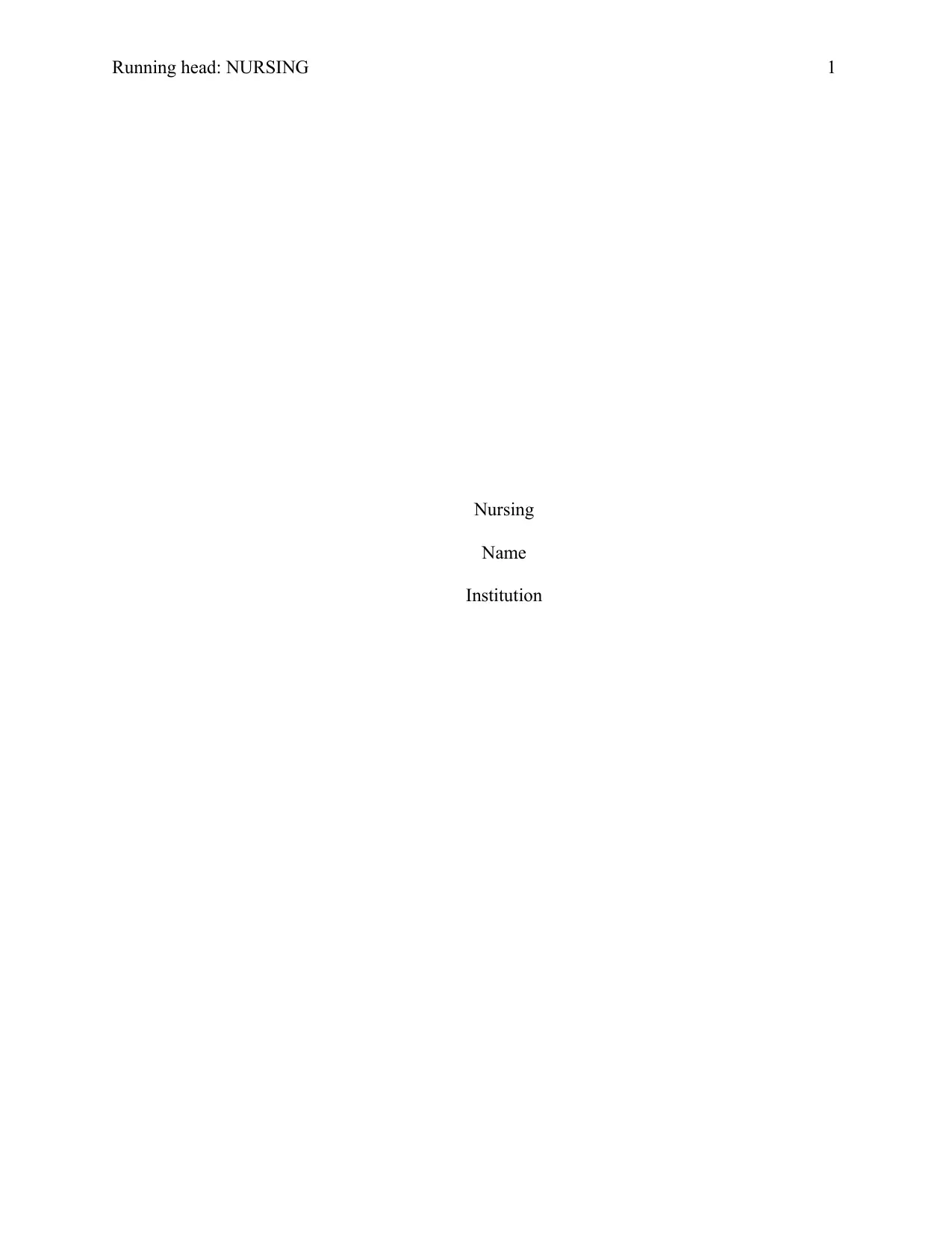
Running head: NURSING 1
Nursing
Name
Institution
Nursing
Name
Institution
Paraphrase This Document
Need a fresh take? Get an instant paraphrase of this document with our AI Paraphraser
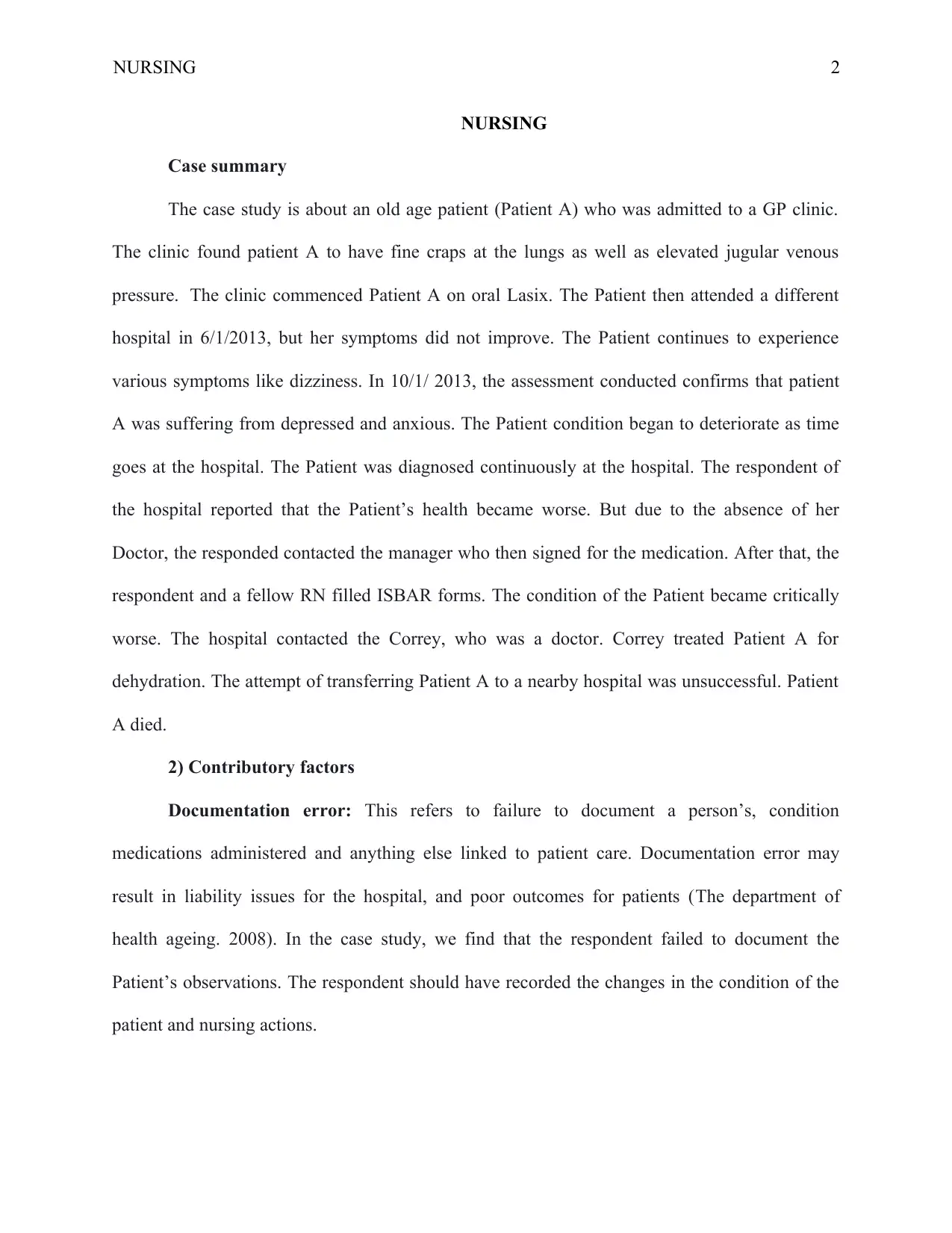
NURSING 2
NURSING
Case summary
The case study is about an old age patient (Patient A) who was admitted to a GP clinic.
The clinic found patient A to have fine craps at the lungs as well as elevated jugular venous
pressure. The clinic commenced Patient A on oral Lasix. The Patient then attended a different
hospital in 6/1/2013, but her symptoms did not improve. The Patient continues to experience
various symptoms like dizziness. In 10/1/ 2013, the assessment conducted confirms that patient
A was suffering from depressed and anxious. The Patient condition began to deteriorate as time
goes at the hospital. The Patient was diagnosed continuously at the hospital. The respondent of
the hospital reported that the Patient’s health became worse. But due to the absence of her
Doctor, the responded contacted the manager who then signed for the medication. After that, the
respondent and a fellow RN filled ISBAR forms. The condition of the Patient became critically
worse. The hospital contacted the Correy, who was a doctor. Correy treated Patient A for
dehydration. The attempt of transferring Patient A to a nearby hospital was unsuccessful. Patient
A died.
2) Contributory factors
Documentation error: This refers to failure to document a person’s, condition
medications administered and anything else linked to patient care. Documentation error may
result in liability issues for the hospital, and poor outcomes for patients (The department of
health ageing. 2008). In the case study, we find that the respondent failed to document the
Patient’s observations. The respondent should have recorded the changes in the condition of the
patient and nursing actions.
NURSING
Case summary
The case study is about an old age patient (Patient A) who was admitted to a GP clinic.
The clinic found patient A to have fine craps at the lungs as well as elevated jugular venous
pressure. The clinic commenced Patient A on oral Lasix. The Patient then attended a different
hospital in 6/1/2013, but her symptoms did not improve. The Patient continues to experience
various symptoms like dizziness. In 10/1/ 2013, the assessment conducted confirms that patient
A was suffering from depressed and anxious. The Patient condition began to deteriorate as time
goes at the hospital. The Patient was diagnosed continuously at the hospital. The respondent of
the hospital reported that the Patient’s health became worse. But due to the absence of her
Doctor, the responded contacted the manager who then signed for the medication. After that, the
respondent and a fellow RN filled ISBAR forms. The condition of the Patient became critically
worse. The hospital contacted the Correy, who was a doctor. Correy treated Patient A for
dehydration. The attempt of transferring Patient A to a nearby hospital was unsuccessful. Patient
A died.
2) Contributory factors
Documentation error: This refers to failure to document a person’s, condition
medications administered and anything else linked to patient care. Documentation error may
result in liability issues for the hospital, and poor outcomes for patients (The department of
health ageing. 2008). In the case study, we find that the respondent failed to document the
Patient’s observations. The respondent should have recorded the changes in the condition of the
patient and nursing actions.
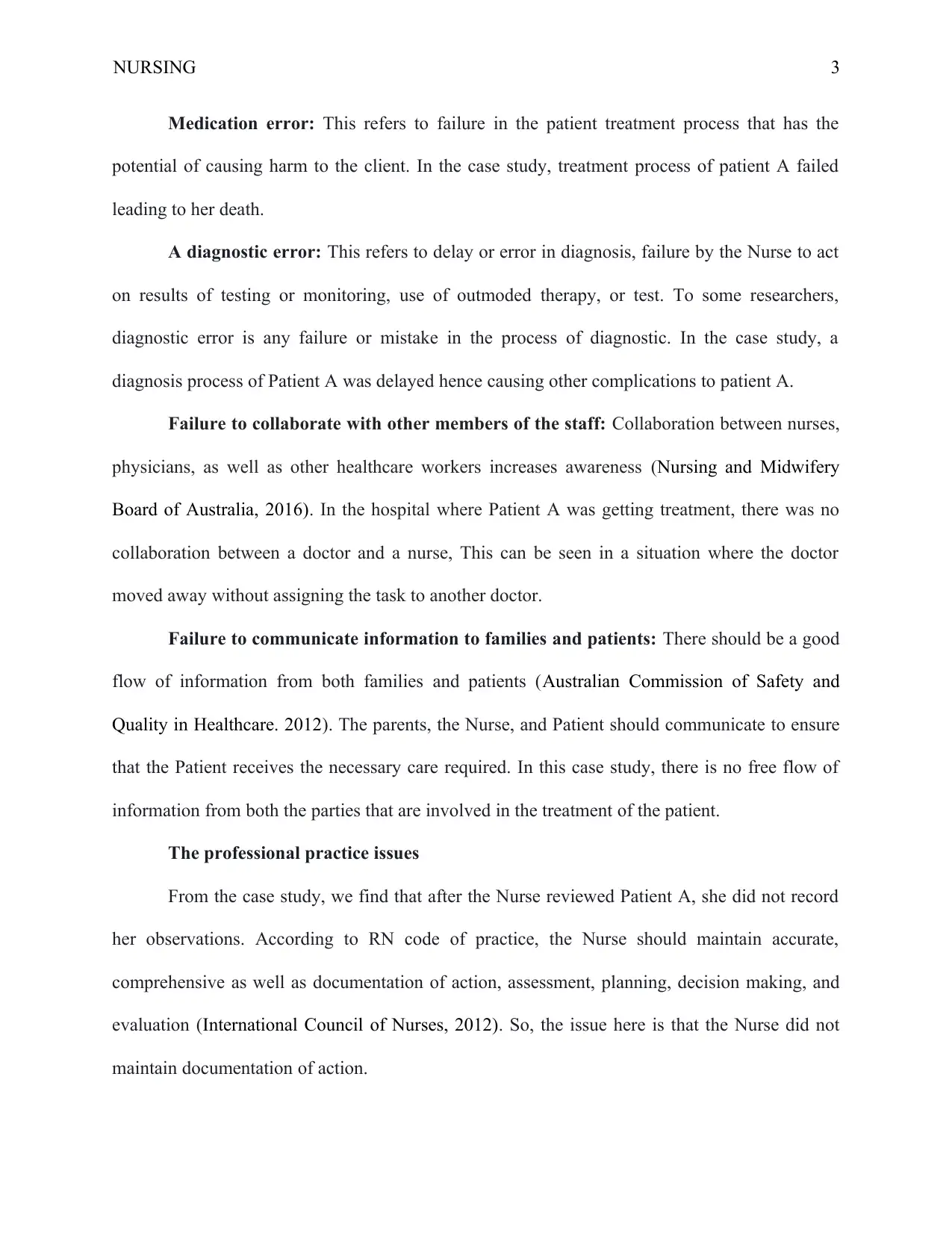
NURSING 3
Medication error: This refers to failure in the patient treatment process that has the
potential of causing harm to the client. In the case study, treatment process of patient A failed
leading to her death.
A diagnostic error: This refers to delay or error in diagnosis, failure by the Nurse to act
on results of testing or monitoring, use of outmoded therapy, or test. To some researchers,
diagnostic error is any failure or mistake in the process of diagnostic. In the case study, a
diagnosis process of Patient A was delayed hence causing other complications to patient A.
Failure to collaborate with other members of the staff: Collaboration between nurses,
physicians, as well as other healthcare workers increases awareness (Nursing and Midwifery
Board of Australia, 2016). In the hospital where Patient A was getting treatment, there was no
collaboration between a doctor and a nurse, This can be seen in a situation where the doctor
moved away without assigning the task to another doctor.
Failure to communicate information to families and patients: There should be a good
flow of information from both families and patients (Australian Commission of Safety and
Quality in Healthcare. 2012). The parents, the Nurse, and Patient should communicate to ensure
that the Patient receives the necessary care required. In this case study, there is no free flow of
information from both the parties that are involved in the treatment of the patient.
The professional practice issues
From the case study, we find that after the Nurse reviewed Patient A, she did not record
her observations. According to RN code of practice, the Nurse should maintain accurate,
comprehensive as well as documentation of action, assessment, planning, decision making, and
evaluation (International Council of Nurses, 2012). So, the issue here is that the Nurse did not
maintain documentation of action.
Medication error: This refers to failure in the patient treatment process that has the
potential of causing harm to the client. In the case study, treatment process of patient A failed
leading to her death.
A diagnostic error: This refers to delay or error in diagnosis, failure by the Nurse to act
on results of testing or monitoring, use of outmoded therapy, or test. To some researchers,
diagnostic error is any failure or mistake in the process of diagnostic. In the case study, a
diagnosis process of Patient A was delayed hence causing other complications to patient A.
Failure to collaborate with other members of the staff: Collaboration between nurses,
physicians, as well as other healthcare workers increases awareness (Nursing and Midwifery
Board of Australia, 2016). In the hospital where Patient A was getting treatment, there was no
collaboration between a doctor and a nurse, This can be seen in a situation where the doctor
moved away without assigning the task to another doctor.
Failure to communicate information to families and patients: There should be a good
flow of information from both families and patients (Australian Commission of Safety and
Quality in Healthcare. 2012). The parents, the Nurse, and Patient should communicate to ensure
that the Patient receives the necessary care required. In this case study, there is no free flow of
information from both the parties that are involved in the treatment of the patient.
The professional practice issues
From the case study, we find that after the Nurse reviewed Patient A, she did not record
her observations. According to RN code of practice, the Nurse should maintain accurate,
comprehensive as well as documentation of action, assessment, planning, decision making, and
evaluation (International Council of Nurses, 2012). So, the issue here is that the Nurse did not
maintain documentation of action.
⊘ This is a preview!⊘
Do you want full access?
Subscribe today to unlock all pages.

Trusted by 1+ million students worldwide
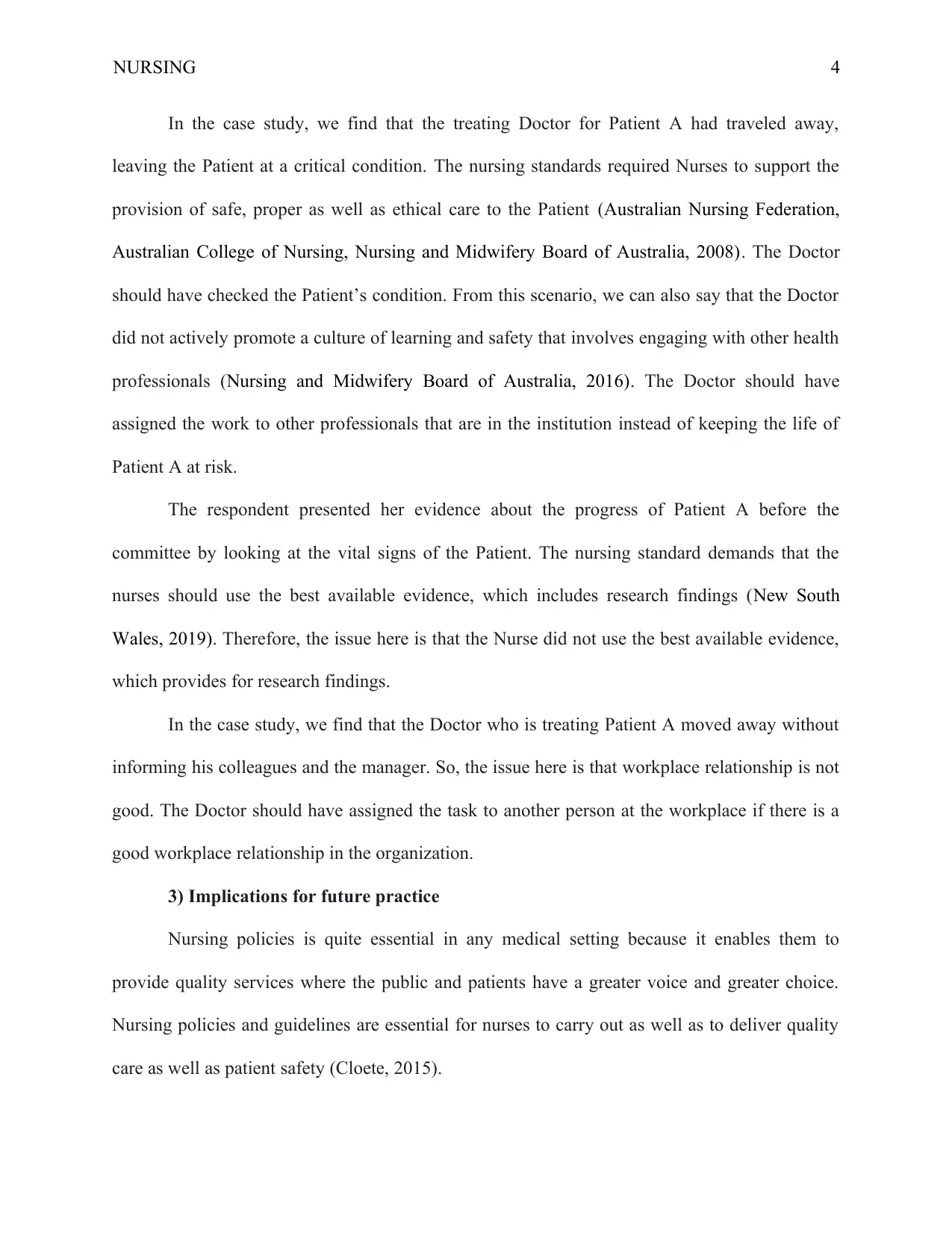
NURSING 4
In the case study, we find that the treating Doctor for Patient A had traveled away,
leaving the Patient at a critical condition. The nursing standards required Nurses to support the
provision of safe, proper as well as ethical care to the Patient (Australian Nursing Federation,
Australian College of Nursing, Nursing and Midwifery Board of Australia, 2008). The Doctor
should have checked the Patient’s condition. From this scenario, we can also say that the Doctor
did not actively promote a culture of learning and safety that involves engaging with other health
professionals (Nursing and Midwifery Board of Australia, 2016). The Doctor should have
assigned the work to other professionals that are in the institution instead of keeping the life of
Patient A at risk.
The respondent presented her evidence about the progress of Patient A before the
committee by looking at the vital signs of the Patient. The nursing standard demands that the
nurses should use the best available evidence, which includes research findings (New South
Wales, 2019). Therefore, the issue here is that the Nurse did not use the best available evidence,
which provides for research findings.
In the case study, we find that the Doctor who is treating Patient A moved away without
informing his colleagues and the manager. So, the issue here is that workplace relationship is not
good. The Doctor should have assigned the task to another person at the workplace if there is a
good workplace relationship in the organization.
3) Implications for future practice
Nursing policies is quite essential in any medical setting because it enables them to
provide quality services where the public and patients have a greater voice and greater choice.
Nursing policies and guidelines are essential for nurses to carry out as well as to deliver quality
care as well as patient safety (Cloete, 2015).
In the case study, we find that the treating Doctor for Patient A had traveled away,
leaving the Patient at a critical condition. The nursing standards required Nurses to support the
provision of safe, proper as well as ethical care to the Patient (Australian Nursing Federation,
Australian College of Nursing, Nursing and Midwifery Board of Australia, 2008). The Doctor
should have checked the Patient’s condition. From this scenario, we can also say that the Doctor
did not actively promote a culture of learning and safety that involves engaging with other health
professionals (Nursing and Midwifery Board of Australia, 2016). The Doctor should have
assigned the work to other professionals that are in the institution instead of keeping the life of
Patient A at risk.
The respondent presented her evidence about the progress of Patient A before the
committee by looking at the vital signs of the Patient. The nursing standard demands that the
nurses should use the best available evidence, which includes research findings (New South
Wales, 2019). Therefore, the issue here is that the Nurse did not use the best available evidence,
which provides for research findings.
In the case study, we find that the Doctor who is treating Patient A moved away without
informing his colleagues and the manager. So, the issue here is that workplace relationship is not
good. The Doctor should have assigned the task to another person at the workplace if there is a
good workplace relationship in the organization.
3) Implications for future practice
Nursing policies is quite essential in any medical setting because it enables them to
provide quality services where the public and patients have a greater voice and greater choice.
Nursing policies and guidelines are essential for nurses to carry out as well as to deliver quality
care as well as patient safety (Cloete, 2015).
Paraphrase This Document
Need a fresh take? Get an instant paraphrase of this document with our AI Paraphraser
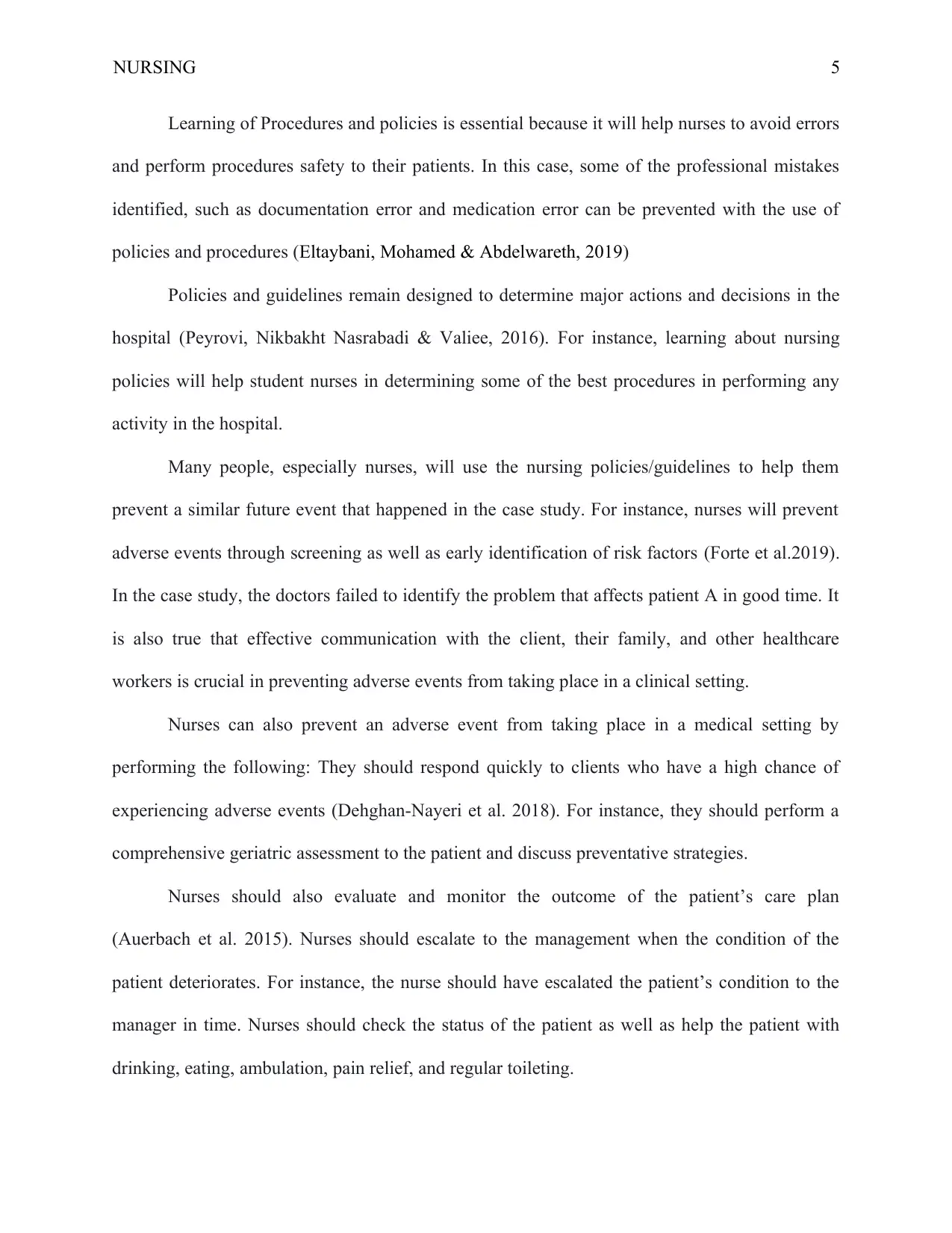
NURSING 5
Learning of Procedures and policies is essential because it will help nurses to avoid errors
and perform procedures safety to their patients. In this case, some of the professional mistakes
identified, such as documentation error and medication error can be prevented with the use of
policies and procedures (Eltaybani, Mohamed & Abdelwareth, 2019)
Policies and guidelines remain designed to determine major actions and decisions in the
hospital (Peyrovi, Nikbakht Nasrabadi & Valiee, 2016). For instance, learning about nursing
policies will help student nurses in determining some of the best procedures in performing any
activity in the hospital.
Many people, especially nurses, will use the nursing policies/guidelines to help them
prevent a similar future event that happened in the case study. For instance, nurses will prevent
adverse events through screening as well as early identification of risk factors (Forte et al.2019).
In the case study, the doctors failed to identify the problem that affects patient A in good time. It
is also true that effective communication with the client, their family, and other healthcare
workers is crucial in preventing adverse events from taking place in a clinical setting.
Nurses can also prevent an adverse event from taking place in a medical setting by
performing the following: They should respond quickly to clients who have a high chance of
experiencing adverse events (Dehghan-Nayeri et al. 2018). For instance, they should perform a
comprehensive geriatric assessment to the patient and discuss preventative strategies.
Nurses should also evaluate and monitor the outcome of the patient’s care plan
(Auerbach et al. 2015). Nurses should escalate to the management when the condition of the
patient deteriorates. For instance, the nurse should have escalated the patient’s condition to the
manager in time. Nurses should check the status of the patient as well as help the patient with
drinking, eating, ambulation, pain relief, and regular toileting.
Learning of Procedures and policies is essential because it will help nurses to avoid errors
and perform procedures safety to their patients. In this case, some of the professional mistakes
identified, such as documentation error and medication error can be prevented with the use of
policies and procedures (Eltaybani, Mohamed & Abdelwareth, 2019)
Policies and guidelines remain designed to determine major actions and decisions in the
hospital (Peyrovi, Nikbakht Nasrabadi & Valiee, 2016). For instance, learning about nursing
policies will help student nurses in determining some of the best procedures in performing any
activity in the hospital.
Many people, especially nurses, will use the nursing policies/guidelines to help them
prevent a similar future event that happened in the case study. For instance, nurses will prevent
adverse events through screening as well as early identification of risk factors (Forte et al.2019).
In the case study, the doctors failed to identify the problem that affects patient A in good time. It
is also true that effective communication with the client, their family, and other healthcare
workers is crucial in preventing adverse events from taking place in a clinical setting.
Nurses can also prevent an adverse event from taking place in a medical setting by
performing the following: They should respond quickly to clients who have a high chance of
experiencing adverse events (Dehghan-Nayeri et al. 2018). For instance, they should perform a
comprehensive geriatric assessment to the patient and discuss preventative strategies.
Nurses should also evaluate and monitor the outcome of the patient’s care plan
(Auerbach et al. 2015). Nurses should escalate to the management when the condition of the
patient deteriorates. For instance, the nurse should have escalated the patient’s condition to the
manager in time. Nurses should check the status of the patient as well as help the patient with
drinking, eating, ambulation, pain relief, and regular toileting.
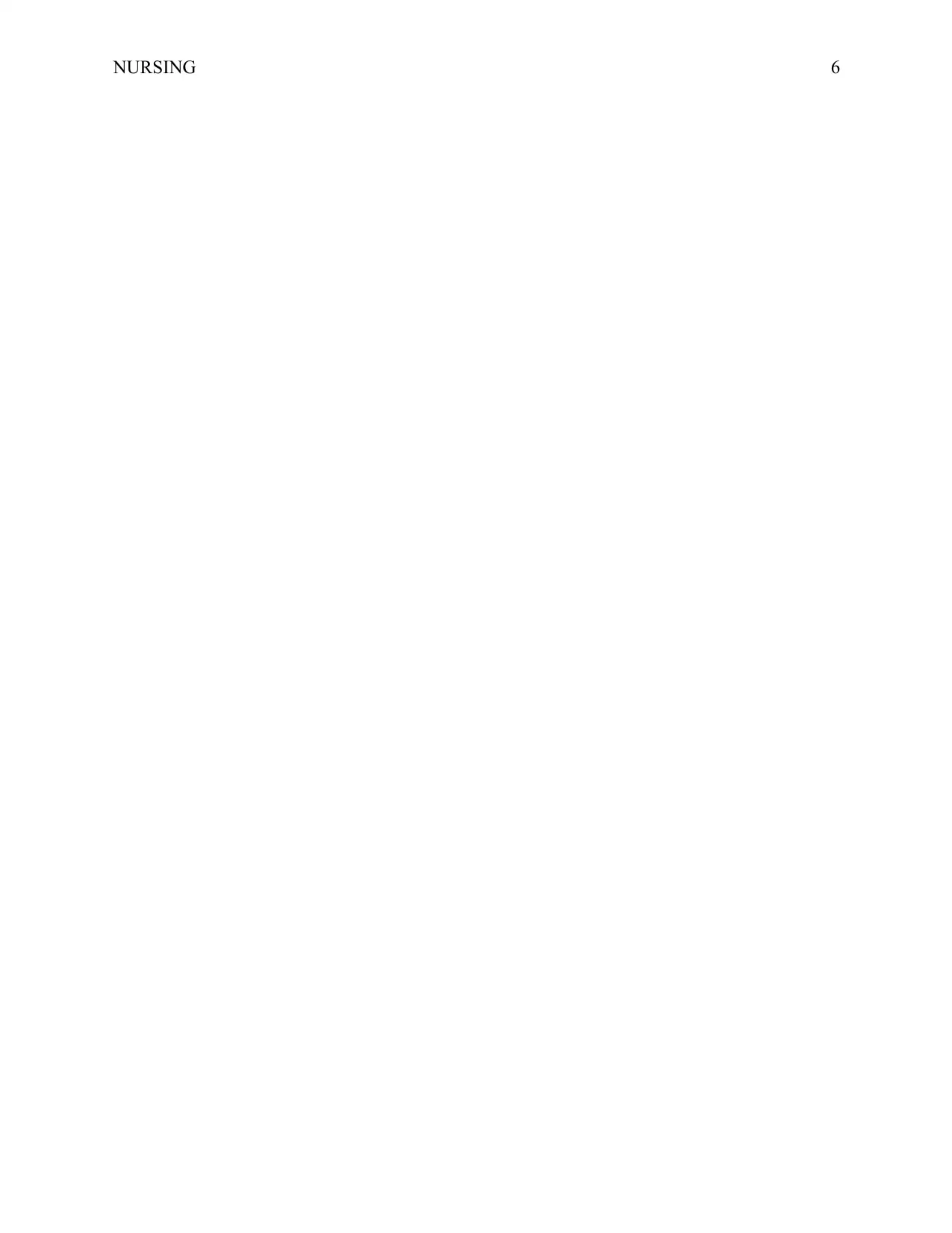
NURSING 6
⊘ This is a preview!⊘
Do you want full access?
Subscribe today to unlock all pages.

Trusted by 1+ million students worldwide
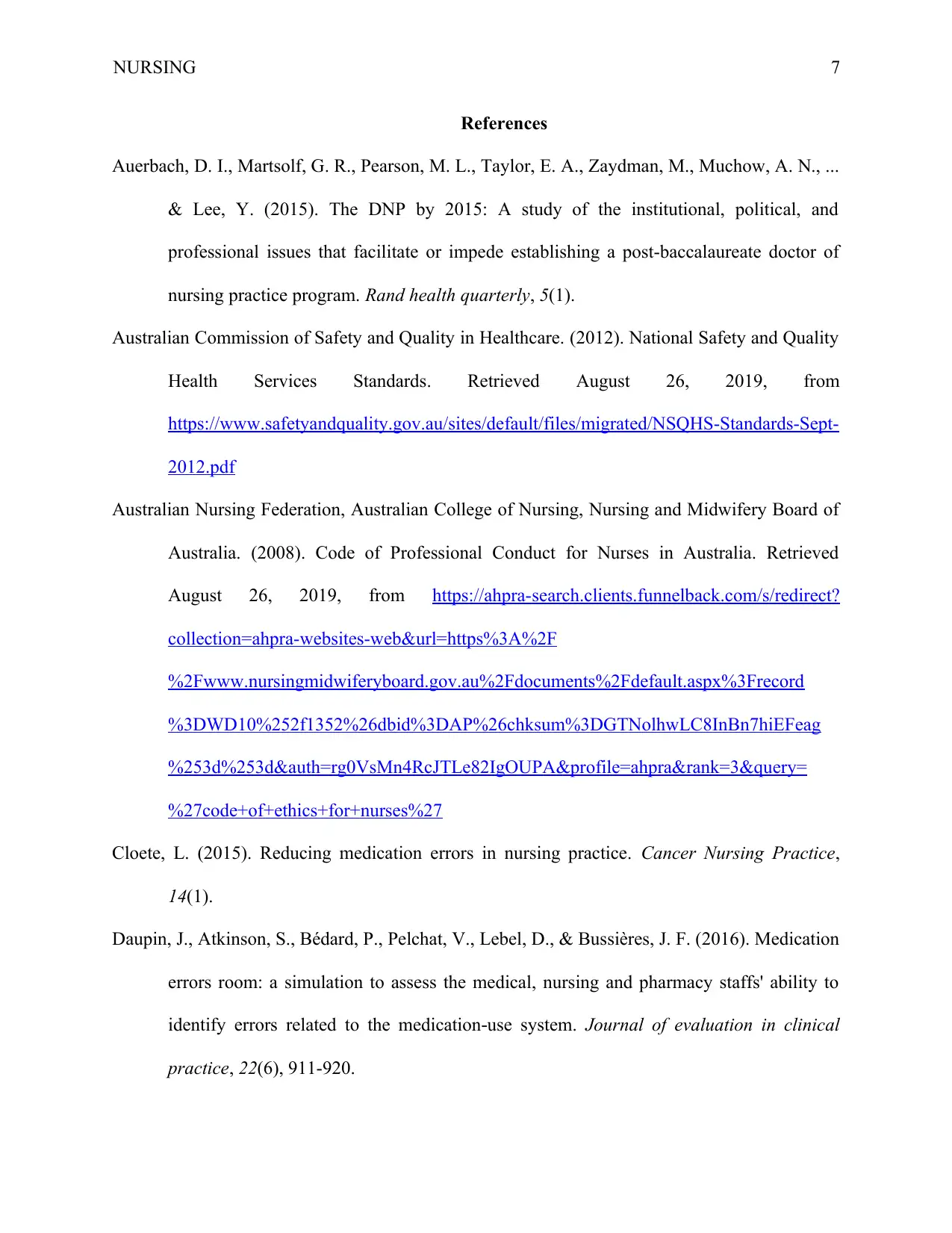
NURSING 7
References
Auerbach, D. I., Martsolf, G. R., Pearson, M. L., Taylor, E. A., Zaydman, M., Muchow, A. N., ...
& Lee, Y. (2015). The DNP by 2015: A study of the institutional, political, and
professional issues that facilitate or impede establishing a post-baccalaureate doctor of
nursing practice program. Rand health quarterly, 5(1).
Australian Commission of Safety and Quality in Healthcare. (2012). National Safety and Quality
Health Services Standards. Retrieved August 26, 2019, from
https://www.safetyandquality.gov.au/sites/default/files/migrated/NSQHS-Standards-Sept-
2012.pdf
Australian Nursing Federation, Australian College of Nursing, Nursing and Midwifery Board of
Australia. (2008). Code of Professional Conduct for Nurses in Australia. Retrieved
August 26, 2019, from https://ahpra-search.clients.funnelback.com/s/redirect?
collection=ahpra-websites-web&url=https%3A%2F
%2Fwww.nursingmidwiferyboard.gov.au%2Fdocuments%2Fdefault.aspx%3Frecord
%3DWD10%252f1352%26dbid%3DAP%26chksum%3DGTNolhwLC8InBn7hiEFeag
%253d%253d&auth=rg0VsMn4RcJTLe82IgOUPA&profile=ahpra&rank=3&query=
%27code+of+ethics+for+nurses%27
Cloete, L. (2015). Reducing medication errors in nursing practice. Cancer Nursing Practice,
14(1).
Daupin, J., Atkinson, S., Bédard, P., Pelchat, V., Lebel, D., & Bussières, J. F. (2016). Medication
errors room: a simulation to assess the medical, nursing and pharmacy staffs' ability to
identify errors related to the medication use system.‐ Journal of evaluation in clinical
practice, 22(6), 911-920.
References
Auerbach, D. I., Martsolf, G. R., Pearson, M. L., Taylor, E. A., Zaydman, M., Muchow, A. N., ...
& Lee, Y. (2015). The DNP by 2015: A study of the institutional, political, and
professional issues that facilitate or impede establishing a post-baccalaureate doctor of
nursing practice program. Rand health quarterly, 5(1).
Australian Commission of Safety and Quality in Healthcare. (2012). National Safety and Quality
Health Services Standards. Retrieved August 26, 2019, from
https://www.safetyandquality.gov.au/sites/default/files/migrated/NSQHS-Standards-Sept-
2012.pdf
Australian Nursing Federation, Australian College of Nursing, Nursing and Midwifery Board of
Australia. (2008). Code of Professional Conduct for Nurses in Australia. Retrieved
August 26, 2019, from https://ahpra-search.clients.funnelback.com/s/redirect?
collection=ahpra-websites-web&url=https%3A%2F
%2Fwww.nursingmidwiferyboard.gov.au%2Fdocuments%2Fdefault.aspx%3Frecord
%3DWD10%252f1352%26dbid%3DAP%26chksum%3DGTNolhwLC8InBn7hiEFeag
%253d%253d&auth=rg0VsMn4RcJTLe82IgOUPA&profile=ahpra&rank=3&query=
%27code+of+ethics+for+nurses%27
Cloete, L. (2015). Reducing medication errors in nursing practice. Cancer Nursing Practice,
14(1).
Daupin, J., Atkinson, S., Bédard, P., Pelchat, V., Lebel, D., & Bussières, J. F. (2016). Medication
errors room: a simulation to assess the medical, nursing and pharmacy staffs' ability to
identify errors related to the medication use system.‐ Journal of evaluation in clinical
practice, 22(6), 911-920.
Paraphrase This Document
Need a fresh take? Get an instant paraphrase of this document with our AI Paraphraser
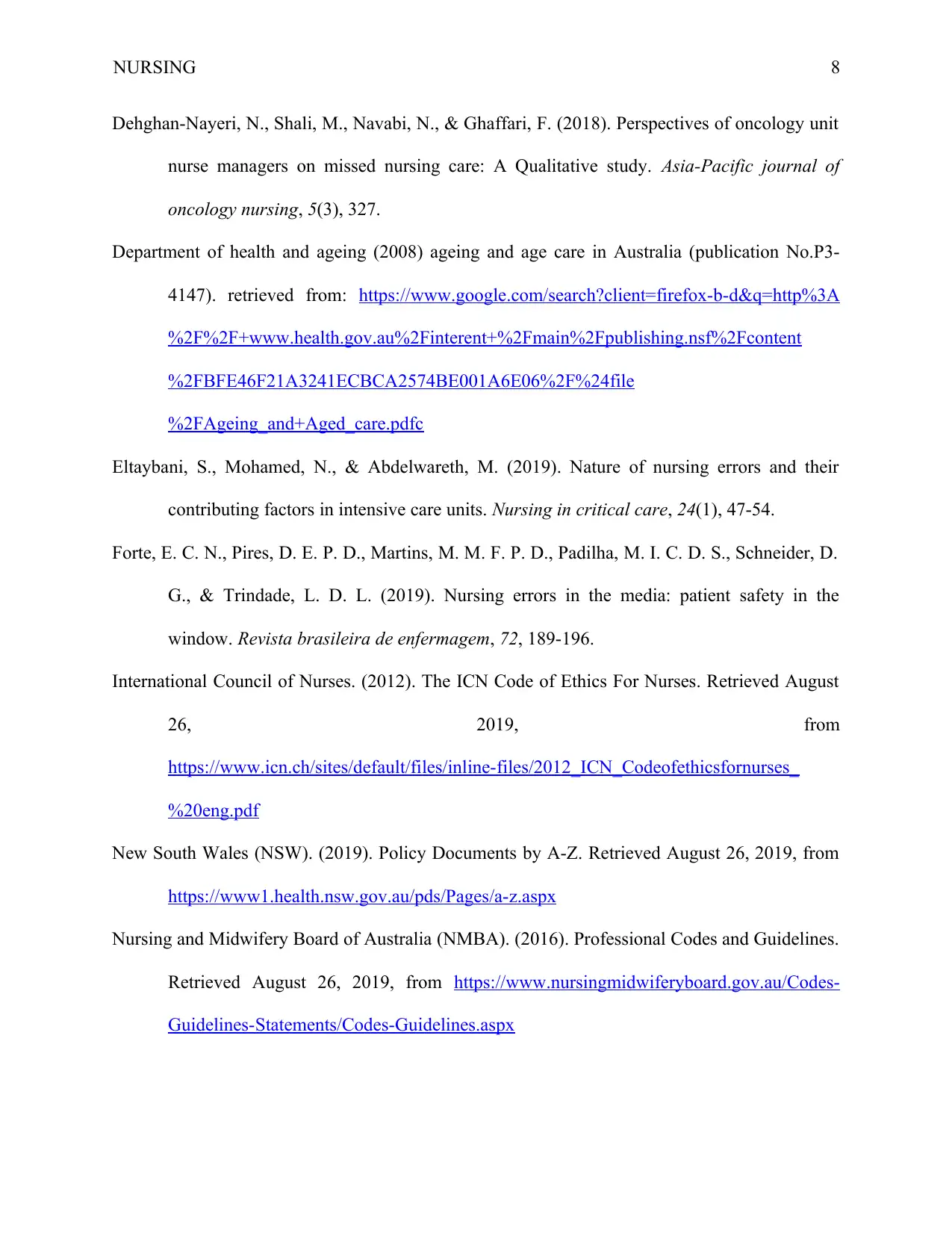
NURSING 8
Dehghan-Nayeri, N., Shali, M., Navabi, N., & Ghaffari, F. (2018). Perspectives of oncology unit
nurse managers on missed nursing care: A Qualitative study. Asia-Pacific journal of
oncology nursing, 5(3), 327.
Department of health and ageing (2008) ageing and age care in Australia (publication No.P3-
4147). retrieved from: https://www.google.com/search?client=firefox-b-d&q=http%3A
%2F%2F+www.health.gov.au%2Finterent+%2Fmain%2Fpublishing.nsf%2Fcontent
%2FBFE46F21A3241ECBCA2574BE001A6E06%2F%24file
%2FAgeing_and+Aged_care.pdfc
Eltaybani, S., Mohamed, N., & Abdelwareth, M. (2019). Nature of nursing errors and their
contributing factors in intensive care units. Nursing in critical care, 24(1), 47-54.
Forte, E. C. N., Pires, D. E. P. D., Martins, M. M. F. P. D., Padilha, M. I. C. D. S., Schneider, D.
G., & Trindade, L. D. L. (2019). Nursing errors in the media: patient safety in the
window. Revista brasileira de enfermagem, 72, 189-196.
International Council of Nurses. (2012). The ICN Code of Ethics For Nurses. Retrieved August
26, 2019, from
https://www.icn.ch/sites/default/files/inline-files/2012_ICN_Codeofethicsfornurses_
%20eng.pdf
New South Wales (NSW). (2019). Policy Documents by A-Z. Retrieved August 26, 2019, from
https://www1.health.nsw.gov.au/pds/Pages/a-z.aspx
Nursing and Midwifery Board of Australia (NMBA). (2016). Professional Codes and Guidelines.
Retrieved August 26, 2019, from https://www.nursingmidwiferyboard.gov.au/Codes-
Guidelines-Statements/Codes-Guidelines.aspx
Dehghan-Nayeri, N., Shali, M., Navabi, N., & Ghaffari, F. (2018). Perspectives of oncology unit
nurse managers on missed nursing care: A Qualitative study. Asia-Pacific journal of
oncology nursing, 5(3), 327.
Department of health and ageing (2008) ageing and age care in Australia (publication No.P3-
4147). retrieved from: https://www.google.com/search?client=firefox-b-d&q=http%3A
%2F%2F+www.health.gov.au%2Finterent+%2Fmain%2Fpublishing.nsf%2Fcontent
%2FBFE46F21A3241ECBCA2574BE001A6E06%2F%24file
%2FAgeing_and+Aged_care.pdfc
Eltaybani, S., Mohamed, N., & Abdelwareth, M. (2019). Nature of nursing errors and their
contributing factors in intensive care units. Nursing in critical care, 24(1), 47-54.
Forte, E. C. N., Pires, D. E. P. D., Martins, M. M. F. P. D., Padilha, M. I. C. D. S., Schneider, D.
G., & Trindade, L. D. L. (2019). Nursing errors in the media: patient safety in the
window. Revista brasileira de enfermagem, 72, 189-196.
International Council of Nurses. (2012). The ICN Code of Ethics For Nurses. Retrieved August
26, 2019, from
https://www.icn.ch/sites/default/files/inline-files/2012_ICN_Codeofethicsfornurses_
%20eng.pdf
New South Wales (NSW). (2019). Policy Documents by A-Z. Retrieved August 26, 2019, from
https://www1.health.nsw.gov.au/pds/Pages/a-z.aspx
Nursing and Midwifery Board of Australia (NMBA). (2016). Professional Codes and Guidelines.
Retrieved August 26, 2019, from https://www.nursingmidwiferyboard.gov.au/Codes-
Guidelines-Statements/Codes-Guidelines.aspx
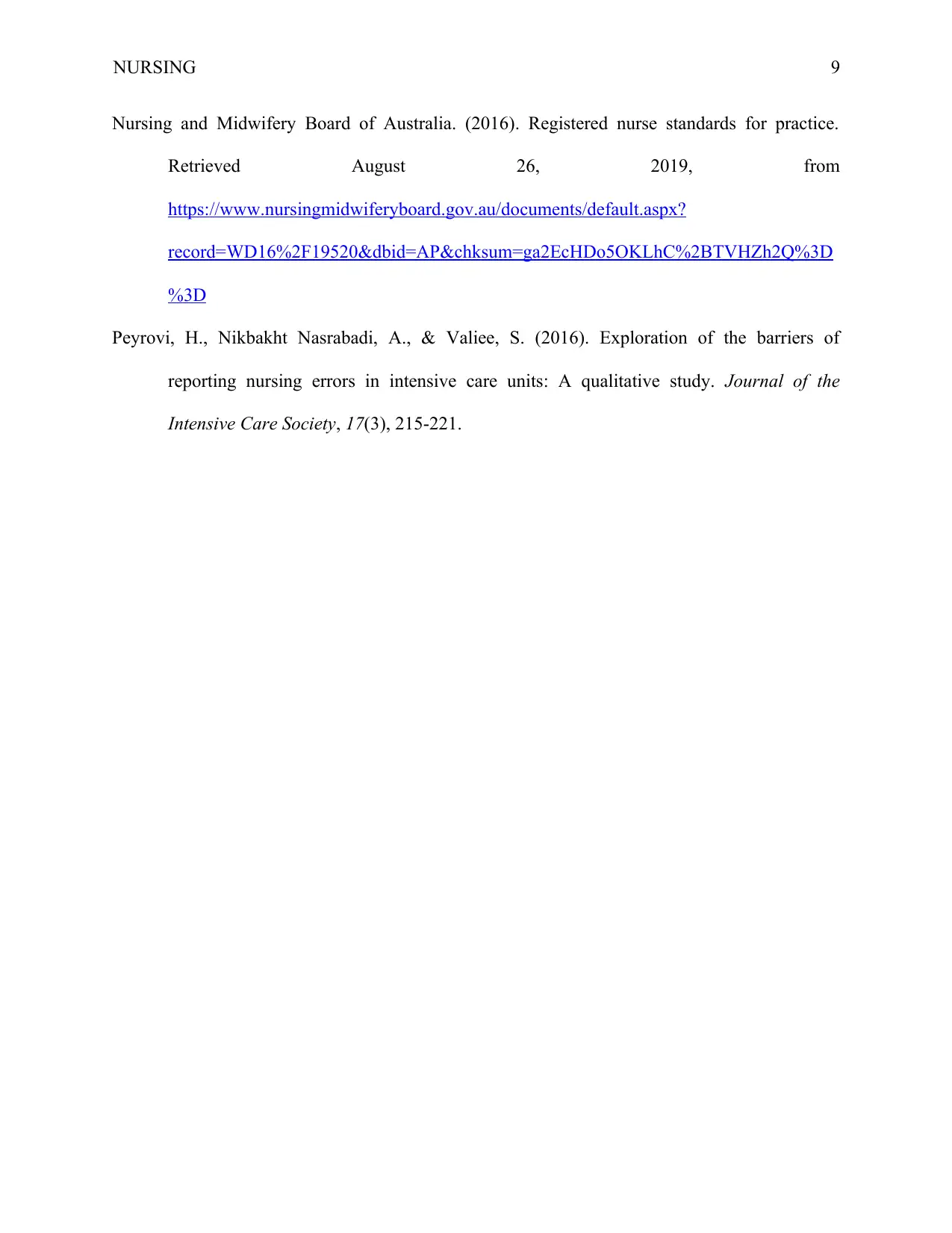
NURSING 9
Nursing and Midwifery Board of Australia. (2016). Registered nurse standards for practice.
Retrieved August 26, 2019, from
https://www.nursingmidwiferyboard.gov.au/documents/default.aspx?
record=WD16%2F19520&dbid=AP&chksum=ga2EcHDo5OKLhC%2BTVHZh2Q%3D
%3D
Peyrovi, H., Nikbakht Nasrabadi, A., & Valiee, S. (2016). Exploration of the barriers of
reporting nursing errors in intensive care units: A qualitative study. Journal of the
Intensive Care Society, 17(3), 215-221.
Nursing and Midwifery Board of Australia. (2016). Registered nurse standards for practice.
Retrieved August 26, 2019, from
https://www.nursingmidwiferyboard.gov.au/documents/default.aspx?
record=WD16%2F19520&dbid=AP&chksum=ga2EcHDo5OKLhC%2BTVHZh2Q%3D
%3D
Peyrovi, H., Nikbakht Nasrabadi, A., & Valiee, S. (2016). Exploration of the barriers of
reporting nursing errors in intensive care units: A qualitative study. Journal of the
Intensive Care Society, 17(3), 215-221.
⊘ This is a preview!⊘
Do you want full access?
Subscribe today to unlock all pages.

Trusted by 1+ million students worldwide
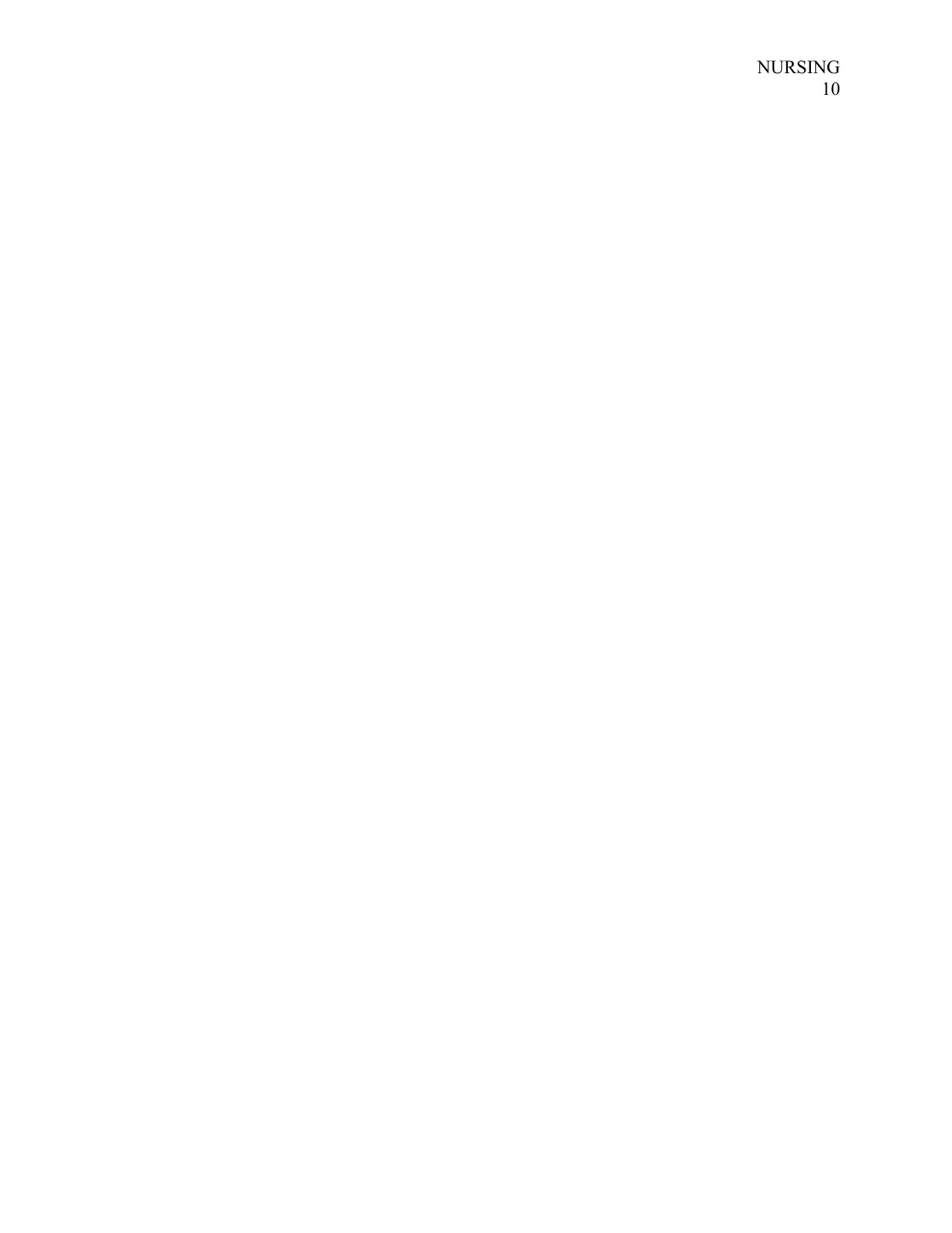
NURSING
10
10
1 out of 10
Related Documents
Your All-in-One AI-Powered Toolkit for Academic Success.
+13062052269
info@desklib.com
Available 24*7 on WhatsApp / Email
![[object Object]](/_next/static/media/star-bottom.7253800d.svg)
Unlock your academic potential
Copyright © 2020–2025 A2Z Services. All Rights Reserved. Developed and managed by ZUCOL.




